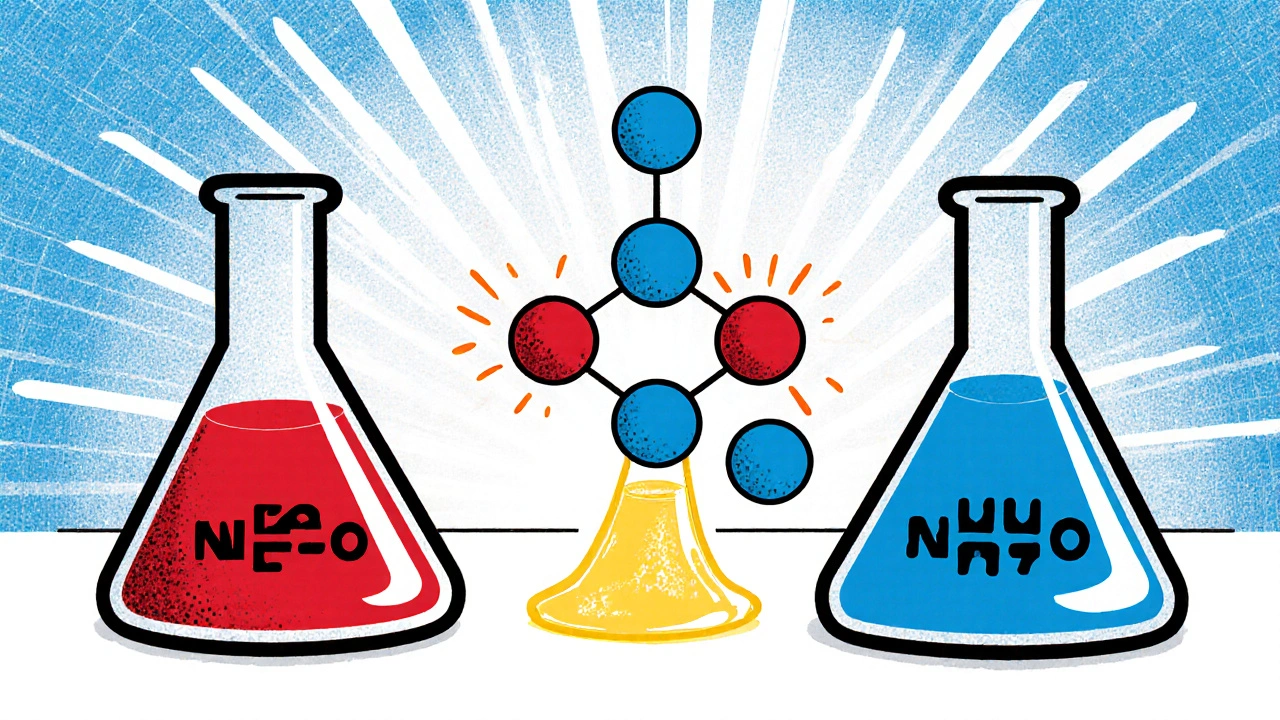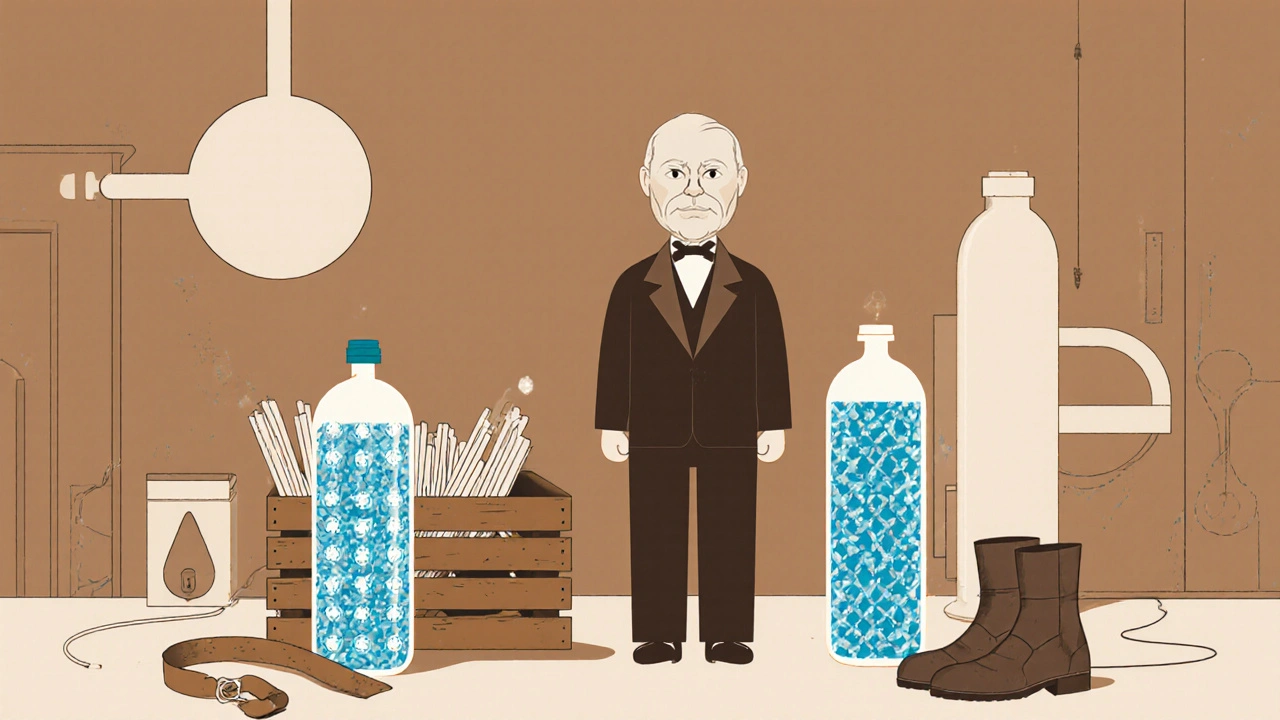Nitroglycerin Explosion Explained: Chemistry, History, and Safety

Nitroglycerin Temperature Safety Calculator
Temperature Stability Calculator
Enter temperature in Celsius to determine nitroglycerin stability level based on article guidelines.
Stability Assessment
Select temperature to calculateNo calculation performed yet.
When people hear nitroglycerin explosion, they picture a sudden, deafening blast- but what really makes nitroglycerin such a powerful detonator? Nitroglycerin is a dense, oily liquid that belongs to the family of nitrate esters. Its chemical formula, C₃H₅N₃O₉, hides a highly unstable molecular structure that releases massive energy when triggered.
What is nitroglycerin?
Glycerol is a simple triol (C₃H₈O₃) that serves as the backbone for nitroglycerin. By reacting glycerol with a mixture of Nitric Acid and Sulfuric Acid, the three hydroxyl groups become nitrate esters, forming the explosive molecule.
How the explosive reaction works
The core of any blast is an exothermic redox reaction. In nitroglycerin, the nitrate groups act as internal oxidizers, providing both fuel (carbon and hydrogen) and oxygen in a single molecule. When a shock wave or heat initiates the reaction, the following simplified equation fires:
C₃H₅N₃O₉ → 3 CO₂ + 2.5 H₂O + 1.5 N₂ + 1.5 O₂ + Energy
Within microseconds, the products expand, creating a high-pressure gas front that travels faster than the speed of sound- the hallmark of a detonation. The presence of Oxygen inside the molecule means the reaction does not rely on external air, making nitroglycerin capable of blasting underwater or in sealed chambers.
Factors that affect explosivity
- Temperature: Raising temperature lowers the activation energy, making spontaneous decomposition more likely. Above 70 °C, nitroglycerin can self‑ignite.
- Impurities: Trace acids or metals act as catalysts, accelerating decomposition. That’s why industrial grades are kept at a precise pH.
- Physical form: Pure liquid nitroglycerin is extremely sensitive. When absorbed into an inert porous material (like diatomaceous earth), it becomes Dynamite, dramatically reducing shock sensitivity while preserving explosive power.
Safety and handling guidelines
Because a tiny jolt can set off a blast, strict protocols govern storage and transport. Key measures include:
- Maintain temperatures below 20 °C using climate‑controlled containers.
- Use stabilizers such as Carbonate buffers to neutralize stray acids.
- Store in small, sealed ampoules separated by inert partitions to prevent chain reactions.
- Equip personnel with anti‑static footwear and grounding straps.
When a controlled blast is required, engineers often prefer TNT (trinitrotoluene) because it is less temperature‑sensitive, even though nitroglycerin releases more energy per kilogram.

Historical perspective
Alfred Nobel first commercialized nitroglycerin in 1867 by stabilizing it in a porous matrix, creating the first modern explosive- Dynamite. Before that, nitroglycerin was used in medicine as a vasodilator; the same molecule that can open clogged arteries also powers some of the biggest blasts in history.
During World War I, nitroglycerin‑based gelatin explosives (known as “gelignite”) supplied the Allies with a high‑explosive that could be molded into shells and demolition charges. Its high detonation velocity (around 7,700 m/s) made it ideal for breaching fortifications.
Comparison with other common explosives
| Property | Nitroglycerin | TNT | Dynamite (gelatinized nitroglycerin) |
|---|---|---|---|
| Detonation Velocity (m/s) | 7,700 | 6,900 | 7,300 |
| Density (g/cm³) | 1.60 | 1.65 | 1.55 |
| Sensitivity to Shock | Very high | Low | Moderate |
| Stability at 30 °C | Unstable | Stable | Stable (with proper absorbent) |
| Typical Use | Specialty blasting, medical (vasodilator) | General‑purpose munitions | Construction & mining |
Common misconceptions
Many think that nitroglycerin is only a “bomb” chemical. In reality, a tiny dose (0.1 mg) is prescribed for angina because it releases nitric oxide, dilating blood vessels. The difference lies in dosage and delivery method- medical tablets are formulated to release the compound slowly, never as a rapid decomposition.
Another myth: “All explosives work the same way.” While the basic redox principle is shared, the presence of internal oxidizers (as in nitroglycerin) versus reliance on external oxygen (as in gunpowder) creates distinct blast characteristics.

Future directions in explosive research
Scientists are exploring “green explosives” that retain high energy while reducing toxic by‑products. One avenue is modifying the glycerol backbone with bio‑derived nitrates, aiming for a biodegradable version of nitroglycerin. Another is nano‑encapsulation, which could make handling safer by isolating reactive sites until a precise trigger is applied.
Quick reference checklist
- Know the chemical makeup: C₃H₅N₃O₉.
- Maintain temperature < 20 °C.
- Use stabilizers and avoid metal contaminants.
- Prefer absorbed forms (dynamite) for field work.
- Follow regulatory guidelines for transport and disposal.
Frequently Asked Questions
Why does nitroglycerin detonate faster than TNT?
Nitroglycerin contains its own oxygen, so the reaction doesn’t need to draw in external air. This internal oxidizer allows a more rapid release of gas, giving it a higher detonation velocity.
Can nitroglycerin be stored safely for long periods?
Only if it’s kept cool, dry, and in small, sealed ampoules with pH‑neutralizing buffers. Even then, periodic testing is required because it can degrade over years.
What makes dynamite less sensitive than pure nitroglycerin?
Dynamite absorbs nitroglycerin into an inert porous material, physically separating the reactive molecules. This reduces the chance that a shock will affect the entire mass at once.
Is nitroglycerin still used in modern blasting?
Yes, especially in specialized applications where its high energy density is needed, such as seismic charges for oil exploration.
How does medical nitroglycerin differ from the explosive form?
Medical formulations are diluted and administered in micro‑doses that release nitric oxide gradually, never reaching the concentration needed for a rapid exothermic blast.
Understanding the science behind a nitroglycerin explosion helps demystify its power and guides safer handling. Whether you’re a chemist, demolition expert, or curious reader, the key is respecting the chemistry that fuels the blast.
Kimberly Lloyd
October 21, 2025 AT 01:11Reading about nitroglycerin feels like peering into a tiny sun of chemistry, a reminder that even the most volatile things can teach us patience. The way the molecule packs fuel and oxidizer together is a beautiful paradox that mirrors our own contradictions. If we respect its limits, we can harness its power without losing ourselves. Keep exploring, the world is full of hidden wonders.
Sakib Shaikh
November 1, 2025 AT 15:26Yo, let me break it down – nitroglycerin is like the rockstar of explosives, every atom screaming “ignite me!” when you give it even a whisper of shock. The nitrate esters are basically tiny fireworks packed into a liquid, and when they pop, they unleash a thunderstorm of CO₂, H₂O, N₂ and O₂ in micro‑seconds. Temperature? It’s the devil’s trigger – 70 °C and it decides to party on its own. And don’t even get me started on the sheer velocity; it’s a cosmic boom in a bottle.
Lolita Gaela
November 13, 2025 AT 05:13From a thermochemical perspective, nitroglycerin (NG) exemplifies an energetic molecular architecture wherein the internal redox balance is pre‑configured through nitrate esterification of glycerol. The enthalpic release during detonation is primarily governed by the simultaneous oxidation of the carbon backbone and reduction of the nitrogen moieties, resulting in exothermic formation of CO₂, H₂O, N₂ and liberated O₂. Kinetic measurements indicate an onset decomposition half‑life of approximately 3 × 10⁻⁴ s at 25 °C, highlighting the metastable nature of the liquid under ambient conditions. The activation energy, derived from Arrhenius extrapolation, resides near 110 kJ·mol⁻¹, which rationalizes the pronounced temperature sensitivity observed above the 70 °C threshold. Impurity catalysis, often attributable to trace metal ions such as Cu²⁺ or Fe³⁺, can lower this activation barrier by up to 20 kJ·mol⁻¹, thereby accelerating spontaneous exothermic events. In industrial practice, the pH of NG formulations is meticulously buffered to a neutral range, employing carbonate or phosphate systems to quench residual acidity that might otherwise act as a nucleophilic catalyst. The sorptive immobilization of NG onto diatomaceous earth, pioneered by Nobel, introduces a porous matrix that attenuates shock transmission; the resulting dynamite exhibits a reduction in impact sensitivity by several orders of magnitude while preserving a detonation velocity of roughly 7,300 m·s⁻¹. From a materials science standpoint, the mechanical modulus of the absorbent scaffold governs the acoustic impedance matching, which in turn influences the efficiency of the energy transfer during blast initiation. Computational fluid dynamics simulations corroborate that the rapid gas expansion follows a spherical Chapman–Jouguet detonation front, producing peak pressures exceeding 30 GPa in confined geometries. Safety protocols recommend storage temperatures below 20 °C; thermo‑analytical data demonstrate that thermal runaway becomes statistically significant when the thermal mass exceeds 150 J·K⁻¹ under adiabatic conditions. Periodic spectroscopic monitoring, using FTIR or Raman, can detect early onset nitrate decomposition products such as nitrite, serving as an early warning metric for degradation pathways. The modern push toward “green explosives” explores nitrate esters derived from bio‑based polyols, aiming to retain the high oxygen balance while reducing the ecological footprint of synthesis residues. Moreover, nano‑encapsulation techniques employing polymeric vesicles have shown promise in isolating reactive sites, thereby enabling a controlled trigger via external stimuli such as laser‑induced photolysis. In the context of seismic exploration, NG‑based slurry charges are formulated with carrier fluids to modulate impedance, achieving deeper penetration of acoustic energy into sub‑surface strata. Ultimately, the intricate interplay of thermodynamics, kinetics, and materials engineering defines the operational envelope of nitroglycerin, making it a paradigm case study for high‑energy density materials.
Giusto Madison
November 24, 2025 AT 19:00Listen up, if you think temperature control is optional you’re just begging for a disaster. Keep that NG below 20 °C and you’ll avoid the nightmare scenario where a tiny jolt turns the lab into a fireworks show. Use proper pH buffers, seal the ampoules, and never let metal shards touch the liquid-those impurities are the real troublemakers. Treat every handling step like a drill, and you’ll keep the blast where it belongs: on paper, not on the floor.
erica fenty
December 6, 2025 AT 08:46Nitroglycerin is powerful; it’s also picky-keep it cool, keep it clean, keep it contained.